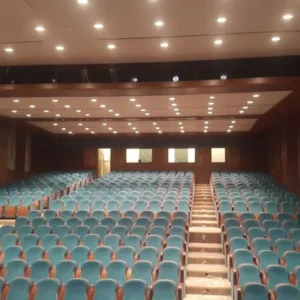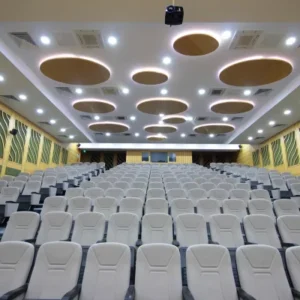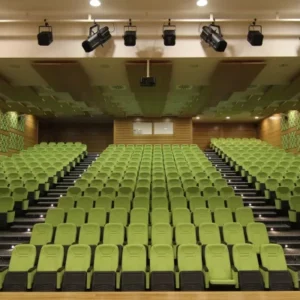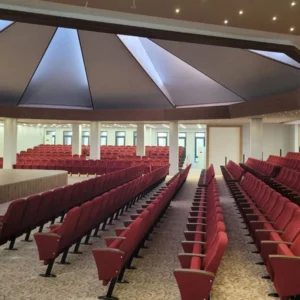If you’ve ever found yourself planning a venue upgrade and wondering how to increase auditorium seating capacity without compromising accessibility, flow, or long-term usability, you’re not alone. This topic sparks genuine interest among venue planners, architects, and project stakeholders globally. Whether it’s a cultural center in Berlin or a university auditorium in Dubai, maximizing seating is a universal challenge — but also an exciting design opportunity.
Table of Contents
When we talk about capacity, it’s not just about squeezing in more seats. It’s about smart engineering, space planning, and strategic implementation of modular seating systems that align with both usage and fire code compliance. So, how can this be done effectively and efficiently?
How to Increase Auditorium Seating Capacity
Boosting capacity isn’t simply about adding rows. Professionals often start by analyzing the auditorium seating layout and identifying underutilized zones — side aisles that are too wide, staggered riser configurations that don’t align, or even misused backstage spaces.
Modern-day auditorium seating solutions go far beyond fixed rows. They integrate retractable auditorium seating, stackable modules, and intelligent rail-mount systems. These flexible installations are changing the rules of spatial limitations and enabling dynamic use of space.
Question: Can a mid-size venue actually add over 15% more seating without expanding its footprint?
Answer: Yes — if you implement retractable systems and reconfigure the layout with optimized chair modules, it’s very possible.
Expand Auditorium Seating Without Changing the Building Shell
You don’t always need to break walls or raise roofs to expand auditorium seating. What you do need is a methodical evaluation of sightlines, aisle spacing, and ADA compliance ratios. A common approach among experienced planners is the reduction of seat width or row depth — marginal changes that often unlock dozens of additional seats in large halls.
Consider Using Modular Auditorium Chairs
Modular auditorium chairs offer varying widths and integrated armrests that can be customized per project, giving you granular control over how many people can sit within a given bay. These chair systems often come with hidden mounting plates or curved back designs that also improve audience density.
Boost Auditorium Capacity Through Vertical Thinking
You’ve heard of vertical farming, but have you considered vertical seating planning? This is a strategy often used in theatre seating expansion projects where the elevation between rows is adjusted slightly to allow for tighter riser depth without compromising viewing angles.
What About Balcony Retrofitting?
Installing or upgrading balcony sections is an often-overlooked method to boost auditorium capacity. By reinforcing existing load-bearing structures, you can add one or two tiers of seating — a technique widely used in opera houses and historical theatres across Europe.
Question: Is vertical expansion a budget-friendly approach?
Answer: Compared to full structural expansion, yes. Especially if the substructure supports the load, balcony retrofits can add 20–30% more seats at a fraction of the cost.
Maximize Auditorium Seats by Rethinking Layout Geometry
Let’s dive into layout strategy. A traditional auditorium seating layout often follows a fan or parallel configuration. But if your venue sees multi-use scenarios — from performances to conferences — then you’ll need flexible auditorium seating that adapts to various audience types.
Curved vs. Straight Row Configurations
Curved rows can follow the natural line of sight better and maximize auditorium seats by reducing corner gaps. Meanwhile, straight rows are more cost-effective but may sacrifice capacity near edges. The optimal solution often lies in a hybrid layout, tailored per event type.
Enhance Venue Seating Capacity With Smart Design Interventions
What separates a good layout from a great one? Thoughtful auditorium space management. It’s not always about the number of seats, but the number of usable seats. A poorly planned exit route or oversized AV booth can eat up valuable space.
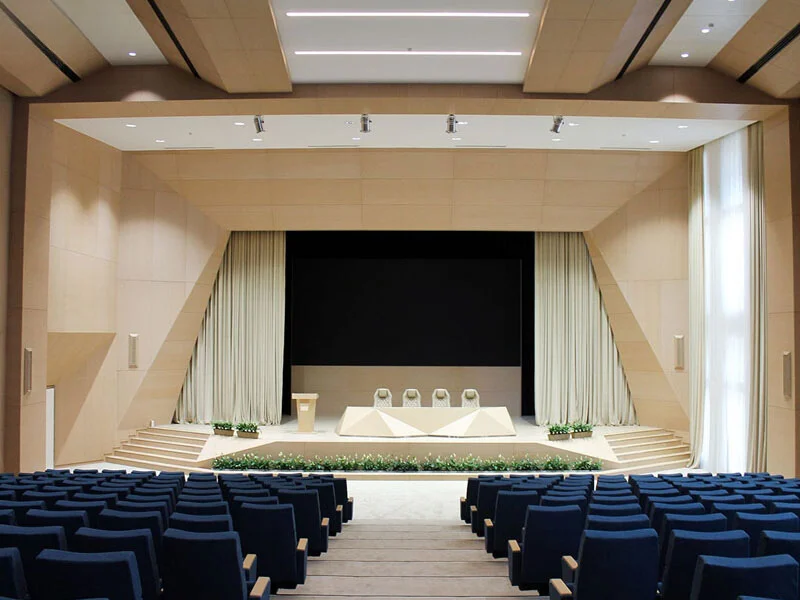
Utilize Dead Zones and Periphery Areas
Dead corners, unused side walls, or back-of-house zones can be activated with retractable auditorium seating or foldable wall-mounted benches — perfect for events with variable audience sizes.
Question: How much extra capacity can be gained from smart periphery usage?
Answer: Depending on venue geometry, up to 8–12% increase in seating is common with minimal visual impact.
Optimize Auditorium Seating for Future-Proof Flexibility
We’re entering an era where venue capacity optimization must also account for future reconfiguration. Flexible auditorium seating systems, designed with scalability in mind, offer plug-and-play modules that allow for quick adjustments in seating density.
Consider These Auditorium Renovation Ideas
- Under-seat ventilation systems: Free up wall space for additional seats.
- Rail-mounted chairs: Enables sliding rows for different configurations.
- Quick-release flooring tiles: Simplifies seat reconfiguration and reduces downtime.
Each of these interventions plays a role in how you optimize auditorium seating for both current and future usage scenarios.
Real-world Impact: Case Studies and Success Metrics
Several international venues have reported up to 20% increase in usable seating after implementing a hybrid of modular auditorium chairs and a revised layout. One well-documented project in Spain used a combination of balcony integration and curved row geometry to go from 650 to 790 seats — all within the existing building shell.
Question: Are these techniques applicable for government-funded venues or only for private sector projects?
Answer: Absolutely applicable to both. In fact, auditorium renovation ideas are often a crucial part of public tenders where maximizing use without expanding the footprint is prioritized.
Conclusion: Balancing Capacity With Quality
So, what have we learned? Increasing auditorium seating capacity isn’t about cramming more chairs. It’s about reimagining the space, using intelligent systems, and choosing the right partner who understands seating ergonomics, circulation patterns, and multi-use demands.
When approached holistically, every cubic meter of the venue can be activated — not just for more people, but for a better experience.
Question: Is there a one-size-fits-all method to increase auditorium seating capacity?
Answer: Not quite. But with the right design partner, your venue can be transformed from standard to standout — strategically, beautifully, and efficiently.



